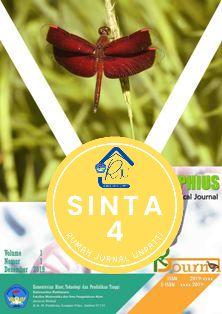International Bibliometric Analysis of Literature on Intrauterine Insemination
Abstract
Intrauterine insemination (IUI) is an artificial insemination method that employs specialized devices to introduce spermatozoa into the uterus. IUI is utilized to address challenges associated with poor reproductive outcomes and to optimize the productivity of livestock. Consequently, its application and utilization has gained global attention and is being continuously developed. Therefore, this study aimed to analyze the global literature on intrauterine insemination research over the preceding decade. Documents related to intrauterine insemination research were presented in the results of a bibliometric study indexed in the Scopus database for the period 2012–2022. On a global scale, the total number of identified documents amounted to 2,721, with an average annual production of 272 documents. Ten countries worldwide were identified as leading contributors to research publications on intrauterine insemination, including the United States with the most document production (n=643), followed by Turkey (n=175), India (n=173), China (n=161), United Kingdom (n=159), Iran (n=153), Netherlands (n=152), Canada (n=140), France (n=131), and Italy (n=129). This study of novelty comprehensive bibliometric analysis to map a decade of global research trends in intrauterine insemination across both human and animal applications. Unlike previous narrative reviews that focused on clinical or technical aspects, this research highlights global collaboration networks, publication dynamics, and emerging thematic hotspots within the IUI domain. Publications related to intrauterine insemination showed an upward trajectory from 2012 until 2021, followed by a decline in 2022. The findings from this analysis provide valuable guidance for future research in the field of intrauterine insemination.
Downloads
References
Abdelkader, A. M., & Yeh, J. (2009). The Potential Use of Intrauterine Insemination as a Basic Option for Infertility: A Review for Technology-Limited Medical Settings. Obstetrics and Gynecology International, 2009(584837), 1-11. https://doi.org/10.1155/2009/584837
Agarwal, A., & Said, T. M. (2003). Role of sperm chromatin abnormalities and DNA damage in male infertility. Human Reproduction Update, 9(4), 331-345. https://doi.org/10.1093/humupd/dmg027
Aitken, R. J., Jones, K. T., & Robertson, S. A. (2012). Reactive oxygen species and sperm function - in sickness and in health. Journal of Andrology, 33(6), 1096-1106. https://doi.org/10.2164/jandrol.112.016535
Amann, R. P., & Waberski, D. (2014). Computer-assisted sperm analysis (CASA): Capabilities and potential developments. Theriogenology, 81(1), 5-17. https://doi.org/10.1016/j.theriogenology.2013.09.004
Berezin, M., Weissenberg, R., Rabinovithc, O., & Lunenfeld, B. (1998). Successful GnRH treatment in a patient with Kallmann’s syndrome, who previously failed HMG/HCG treatment. Andrologia, 20(4), 285-288. https://doi.org/10.1111/j.1439-0272.1988.tb00687.x
Blom, E. (1950). Interpretation of spermatic cytology in bulls. Fertility and Sterility, 1(3), 223-238. https://doi.org/10.1016/S0015-0282(16)30183-2
Buchsbaum, S. (2022). How do we measure the impact of grand challenges. Impatient Optimists. Retrieved 2022-12-23.
De Geyter, C., Calhaz-Jorge, C., Kupka, M. S., Wyns, C., Mocanu, E., Motrenko, T., Scaravelli, G., Smeenk, J.., Vidakovic, S, & Goossens, V. (2018). ART in Europe, 2014: results generated from European registries by ESHRE: The European IVF-monitoring Consortium (EIM) for the European Society of Human Reproduction and Embryology (ESHRE). Human reproduction, 33(9), 1586-1601. https://doi.org/10.1093/humrep/dey242
Dunselman, G. A. J., Vermeulen, N., Becker, C., Calhaz-Jorge, C., D'Hooghe, T., De Bie, B., Heikinheimo, O., Horne, A. W., Kiesel, L., Nap, A. & Prentice, A., Saridogan, E., Soriano, D., & Nelen, W. (2014). ESHRE guideline: management of women with endometriosis, Human reproduction, 29(3), 400-412. https://doi.org/10.1093/humrep/det457
Ferraretti, A. P., Goossens, V., Kupka, M., Bhattacharya, S., de Mouzon, J., Castilla, J. A., Erb, K., Korsak, V., Nyboe Andersen, A & European IVF-monitoring (EIM) and Consortium, for The European Society of Human Reproduction and Embryology (ESHRE). (2013). Assisted reproductive technology in Europe, 2009: results generated from European registers by ESHRE. Human Reproduction, 28(9), 2318-2331. https://doi.org/10.1093/humrep/det278
Ghanem, M. E., Barke, N. I., Emam, M. A., Boghdady, L. A. A., Helal, A. S., Elmetwally, A. G., Hassan, M., Albahlol, I. A., & Elzayat, M. M. (2021). The effects of timing of intrauterine insemination in relation to ovulation and the number of insemination on cycle pregnancy rate in common infertility etiologies. Hum. Reprod., 26(3), 576-583. https://doi.org/10.1093/humrep/deq362
Greer, B. E., & Curtin, J. (2006). ACOG practice bulleting #65: Management of endometrial cancer. Gynecologic Oncology, 107(4), 952-955.
Kadmiel, M., & Cidlowski, J. A. (2013). Glucocorticoid receptor signaling in health and disease. Trends in Pharmacological Sciences, 34(9), 518-530. https://doi.org/10.1016/j.tips.2013.07.003
Kupka, M. S., Ferraretti, A. P., De Mouzon, J., Erb, K., D'Hooghe, T., Castilla, J. A., Calhaz-Jorge, C., De Geyter, C., Goossens, V., Strohmer, H., & Kreuz-Kinderwunschzentrum, S.P.G. (2014). Assisted reproductive technology in Europe, 2010: results generated from European registers by ESHRE. Human reproduction, 29(10), 2099-2113. https://doi.org/10.1093/humrep/deu175
Macer, M.L., & Taylor, H.S. (2012). Endometriosis and infertility: a review of the pathogenesis and treatment of endometriosis-associated infertility. Obstetrics and Gynecology Clinics, 39(4), 535-549. https://doi.org/10.1016/j.tips.2013.07.003
Mervis, J. (2017). Data check: U.S. government share of basic research funding falls below 50%. Science, AAAS.
Ombelet, W., Campo, R., Bosmans, E., & Nijs, M. (2008). Intrauterine insemination (IUI) as a first-line treatment in developing countries and methodological aspects that might influence IUI success. ESHRE Monographs, 2008(1). 64-72. https://doi.org/10.1093/humrep/den165
Pinborg, A., Wennerholm, U. B., Romundstad, L. B., Loft, A., Aittomaki, K., Söderström-Anttila, V., Nygren, K. G., Hazekamp, J., & Bergh, C. (2013). Why do singletons conceived after assisted reproduction technology have adverse perinatal outcome? Systematic review and meta-analysis. Human reproduction update, 19(2), 87-104. https://doi.org/10.1093/humupd/dms044
Sinha, P., Pandey, K., & Srivastava, A. (2017) Factors determining successful intrauterine insemination. International Journal of Reproduction, Contraception, Obstetrics and Gynecology, 6(9), 3887-3891. https://doi.org/10.18203/2320-1770.ijrcog20174028
Sofyantoro, F., Yudha, D. S., Lischer, K., Nuringtyas, T. R., Putri, W. A., Kusuma, W. A., Purwestri, Y. A., and Swasono, R. T. (2022). Bibliometric Analysis of Literature in Snake Venom-Related Research Worldwide (1933-2022). Animals, 12(16), 1-20, 2022, https://doi.org/10.3390/ani12162058
Vercellini, P., Viganò, P., Somigliana, E., & Fedele, L. (2014). Endometriosis: pathogenesis and treatment. Nature Reviews Endocrinology, 10(5), 261-275. https://doi.org/10.1038/nrendo.2013.255
Copyright (c) 2025 Nur Indah Septriani, Pradnya Paramita, Vykra Aulia Firdiana, Tia Silva Norfita, Aisha Sayidinar

This work is licensed under a Creative Commons Attribution-NonCommercial-ShareAlike 4.0 International License.
Authors who propose a manuscript and have it approved for publication know that the manuscript will be registered and become part of the RPBJ. Authors and readers understand that this journal is open and all its contents can be accessed freely, provided that RPBJ is still listed as the source of information. The hope is that this journal can become a vehicle for exchange and scientific knowledge for society and the scientific community, especially in the field of Biology and other branches of science.









